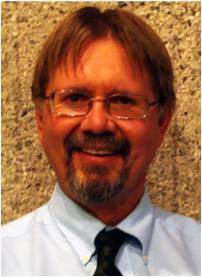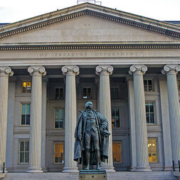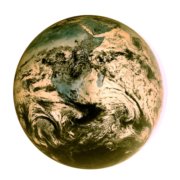The Trophic Theory of Money

[Editor’s update: Read a more recent and thorough article on the trophic theory of money. And/or, watch the video.]
We can only hope that last week’s edition of The Daly News finds its way into the monetary policy arena, but without the cartoon. Something is very wrong with an image of Herman Daly holding a money bag from which a tree is sprouting. The brainy proportioning of Herman is nicely done, but the relationship between the money bag and the tree is completely backwards.

(Public Domain)
This is no mere annoyance, this tree sprouting from a money bag, but rather symbolic of one of the most serious of all the misunderstandings about sustainability. While it may be literally true that “Money doesn’t grow on trees,” that doesn’t mean that trees grow on money! The notion that trees grow on money has gotten us into serious trouble.
Obviously we can use money to buy, plant, and cultivate trees, and to do all kinds of other environmental work. This truism has misled many policy makers into thinking we can solve all environmental problems by throwing more and more money at them. This fallacious reasoning is encouraged by economists touting the so-called “Environmental Kuznets Curve.”
But let’s stick to plain language here. Why is it a fallacy to think that we can solve our burgeoning environmental problems by spending ever more money? Because generating ever more money is what burgeons the environmental problems to begin with! This is where the trophic theory of money comes in.
I introduced the trophic theory in chapter 3 of Shoveling Fuel for a Runaway Train. The theory, in a nutshell, is that the volume of real money (adjusted for inflation) in an economy is a pretty good indicator of the ecological impact of that economy. I believe that the trophic theory of money should become the principal monetary framework in ecological economics, and am grateful that it will be presented in the second edition of the Daly and Farley textbook.
Let’s review the basics here. In ecology, or the economy of nature, “trophic” refers to the flow of energy and nutrients. The lowest trophic level is the producers, or plants that produce their own food in the process of photosynthesis. Herbivorous animals eat plants, and carnivorous animals eat herbivores. That’s the economy of nature in a nutshell. No plants, no animals. In other words, plants are the foundation in the economy of nature, and they must be productive enough to produce more food than needed only for their own reproduction. There has to be surplus plant production in order for herbivores to exist and, in turn, enough herbivores to support the carnivores.
In the human economy, the producers are farmers. Only with an agricultural surplus can there be a division of labor into manufacturing and service sectors. There are, of course, complex nuances to trophic theory, whether applied to the economy of nature or the human economy. I have addressed some of these nuances in the journal Conservation Biology and in our CASSE fact sheet on the Trophic Structure of the Economy. If, for example, you’re wondering where the service providers fit in these trophic levels, I recommend the article in Conservation Biology.
Here, we’ll stick with the basics and tie this trophic theory right back to the origin of money. By “origin,” I’m not referring to the development in the human mind of abstract exchange value, nor to the evolution of monetary instruments from wampum to legal tender. Rather, I am referring to the agricultural and extractive surplus that frees the hands for the division of labor and makes money a meaningful concept and a useful tool of exchange. More real money means more agricultural surplus and therefore more environmental impact.
“Real” money, as we know, means adjusted for inflation. In the simplest of terms, inflation means rising prices, which makes your money worth less. The problem with this simple definition is that it puts the focus on money, so monetary policy miracles are sought to fix the problem. What gets overlooked is that the prices are of real things, real goods and services. That’s why inflation is measured using baskets of goods and services ranging from milk to shirts to haircuts. Even funeral expenses go into the calculation of inflation.
All of these real goods and services occupy some portion of the economic trophic structure. Because this trophic structure as a whole can only increase with increasing agricultural and extractive surplus, an expanding real money supply represents an increasing environmental impact. To think otherwise is to fall into the fallacious trap that “there is no conflict between growing the economy and protecting the environment.” So the trophic theory of money helps to explain why there is a fundamental conflict between economic growth and environmental protection, and why that conflict cannot be solved by throwing evermore money at it.
The trophic theory of money also helps to explain financial and monetary crises. The monetary authorities and banks can extend credit and expand the money supply all they want, but if the capacity of the planet to generate more real money has been exceeded, credit leads to default, and the expanded money supply becomes “unreal” or inflated.
The main thing to remember, though, is that money – real money – represents a unit of pressure on the environment. Benjamin Franklin said, “A penny saved is a penny earned.” Accounting for inflation, we might say, “A dollar spent is a dollar burned.” But what does that mean, “burned?” Let me explain by example.
I started to think about the nature of money when I was the Recreation and Wildlife Director for the San Carlos Apache Tribe in Arizona in the early 1990’s. Apaches love to hunt deer and elk, and venison is a staple in the tribal diet. However, the biggest elk in the world come from the San Carlos Apache Reservation, and it was part of my job to sell a few elk tags per year to the highest bidder, from wherever the bidder might be.
In 1992, I sold three elk tags for $43,000 apiece, for a total of $129,000. The money was earmarked for elk habitat improvement. This seemed like a real “win-win,” we helped the elk while the tribal economy grew. Something struck me as odd about this win-win reasoning, though, given that we sold two of the tags to the owner of the largest old-growth sawmill in the Pacific Northwest.
Actually, it didn’t strike me as odd for very long. As a trained biologist, I viewed this transaction from the perspective of trophic levels. Our buyer of two tags was an extractive agent, operating at the foundation of the economy, and at a very, very large scale. So large a scale that he could afford to fly down to San Carlos on a private jet to hunt elk at the price of $86,000 for the tags alone. He injected additional quantities of money into the tribal economy by purchasing a variety of goods and services, including guiding services during the hunt. He brought real money, straight from… you got it – the trees!
Yes, the money grew on trees, not quite literally, but really quite “really.” The extraction of these trees generated real money, not fiat money eeking out of the fractional reserve system. At that time in the Pacific Northwest, timber was being harvested so rapidly that the old-growth stocks were being liquidated, used up, “burned,” and replaced by second-growth forests, roads, logging facilities, tourist operations, various other economic enterprises, and housing.
So a unit of real money represents a demand on real wealth. A real dollar spent is a real dollar burned. The size of the real money supply is an indicator of environmental impact. None of this is very evident, however, without the trophic theory of money.



Thanks for the post. (Similar ideas have been mentioned on the ArchDruid Report.) It was carried in The Energy Bulletin and the link led to your website. It is refreshing to come across such an island of sanity.
Brian, I somehow missed in skimming through “Shoveling Fuel for a Runaway Train” your idea of using money as a ‘trophic’ measure. That’s one of my main tools, and I’ve used it quite effectively for all kinds of things. Remember I’m a physicist. When you use a measure derived from nature you need to study how well it tracks the subject you are using it to represent, [or alternately, study what unintended subjects it actually does track!]. In the case of using GDP to track energy there is a quite clear and regular global relation between whole system GDP and energy use. See the graphs at the top of “Why efficiency multiplies consumptions” [www.synapse9.com/pub/EffMultiplies.htm]
When it comes to investment, though, the relation between money and reality do NOT conserved. That’s because promises can multiply independent of the realities. That is amplified by our financial systems for using promises as assets, and then continually adding returns to increasing your bets which drives the promises exponentially.
You get what I call a “3 bubble economy”. For product markets money is a useful trophic measure, but for the relation between the financial and product markets it is not. So that is how I arrive at the divergence between the two as being a measure of “misinformation” in the financial system. See [www.synapse9.com/issues/concept$.htm]
This tendency of our system to accumulate misinformation about itself, particularly at growth limits, is one of the things I discovered 30 years ago are completely necessary for system survival to correct. Even today, though, it is not in the alternative economic models people discuss generally, for reasons the authors refuse to tell me. Either it seems such a bitter pill and others hope it isn’t real, or they simply misunderstand, I don’t know. I have a variety of short recent pieces on it clipped from my posts to the UK Finance Lab on my blog [www.synapse9.com/blog]
Oh yea, the easy trophic measure of environmental impacts. Those graphs in the URL above show a remarkably simple and clear consistent relationship between energy use and GDP, and studying why it occurs shows that money is an excellent measure of average global energy use to produce what we spend on.
The energy impact of money is ~6000btu/$ on average, and statistically it appears that most spending depends on the workings of the whole economy, and so that average is a good indicator of the usual impact of spending too. Those observations actually open up a whole new and very practical way to much more accurately estimate the impacts of economic choices. It exposes a consistent 50% to 90% error in the present best available method of impact accounting. I have a paper discussing it on how to calculate whole system EROI using the example of a typical wind farm. http://www.synapse9.com/pub/EROI.Wind-UT&HDS.pdf
I am nearing the completion of my thesis in Cambridge, which compares debt, income and material trends in the Canadian economy. The trends strongly support the trophic theory of money – every % change in income and used credit rather closely correlates with a several-kiloton change in total materials consumed as accounted for by the material flow analysis (MFA) method.
This is the first I’ve heard of this theory. I found it fascinating and it makes a lot of sense. My question would be how the ecological impacts are taken into consideration for farms that are environmentally destructive (run off fertilizers and pesticides, slash and burn, loss of biodiversity to monocultures, etc.) compared against farms that are ecologically productive? Of course, any farm takes up space, which there is only so much of on the planet; but there are a number of agricultural systems that have a positive impact on the environment, which are actually growing topsoil rather than depleting it, cycling nutrients to eliminate needed inputs and waste runoff, and mimicking productive natural ecosystems such as agroforestry mimics the natural forest. Ron and Bev Smith are an example of cow ranchers who increase the topsoil over time and contribute to measures of ecological health such as water-stable-aggregates and biodiversity of plants and soil microorganisms. Aquaponics is a classic example of nutrient cycling.
I agree that the increase in the real money supply must create an increased demand on agricultural producers, however the type of farms operated can range from environmentally destructive to environmentally regenerative, and I wonder how the theory takes this factor into account.
… (thus) … https://stevegluck.com/pyramidal-modeling.html
Brian, your show notes on the video cited in your Editor’s Update got hacked and now contain an extremely long semi-pornographic rant.
Dr. Henshaw’s writing is also brilliant. http://www.synapse9.com/issues/concept$.htm is thorough and well substantiated. Her notion of the loss of information from the financial side of the economy is compelling. Has CASSE adopted her as an advisor or contributor, and if not, why?
The Trophic Theory of Money (TToM) makes great sense, and seems useful for correcting the world’s economic ills. Is there a follow-up paper or essay about debt, fractional reserve, and interest as pertains to the TToM?